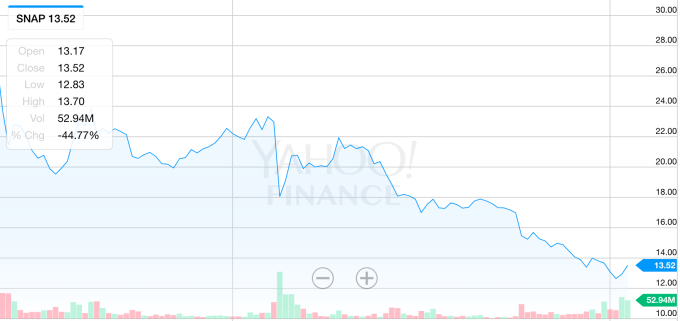Snap’s earnings this week will once again test its place in the advertising universe

Snap will report its second earnings report this week, which will once again look to answer the question: is there room on the advertising spectrum for Snap?
The answer during its last earnings report (its first as a public company) was a resounding to be determined. The company’s stock has been hammered in the past several months falling well below its IPO price, which is not great news for all parties involved. Snap’s employees are probably the worst off here, who are still waiting for lockups to expire as they watch the stock tick lower and lower. For better or worse, that number is a constant indicator of their perceived success — and morale and retention is everything for a company with a creative product like Snap.
Chart time!

Its last earnings report included a pretty hefty loss, though a lot of it was due to stock-based compensation, our new favorite financial asterisk. The company brought in around $149.6 million in revenue on a loss of $2.31 per share, and user growth came in pretty soft as it now has to contend with a much larger product ripping off some of its best features.
This time around, Wall Street is expecting Snap to post a loss of 14 cents per share on revenue of $189.2 million. But the company is still going to be judged on its metrics — like daily active users — even though a company like Snap would die for Wall Street to look closer at other metrics like engaged minutes, daily logins or session time. That’s really their core pitch: they’re smaller than Facebook, but offer different formats and have a way more engaged user base. For Wall Street, that story is still in a sort of twilight zone.
The company has tried to make a number of moves during this quarter, in which the results may not actually end up actualizing til later this year given they are new products. But nonetheless, the company launched its own variation of an advanced advertising manager this week in order to woo big self-serve advertisers looking to launch aggressive campaigns. Snap launched self-serve advertising tools in June, also seemingly in an attempt to get that volume up.
Pinterest, too, has been known to roll out its products at a glacial pace though that’s sped up in recent quarters as it looks to figure out where to fit in the ad spectrum. But Snap might not have the luxury anymore to move so slowly as Facebook aggressively copies its products. Snap needs to be a company, not a product — the latter of which could just be copied and kneecap its growth if done right. That nightmare became reality in the form of Instagram stories, and the Facebook threat is simply not going to go away as the company can flip a switch and reach 2 billion users immediately.
Snap wants to be a camera company. That means it needs a portfolio of products and revenue streams. It does have its semi-nifty Spectacles sunglasses, but the story there too still has to play out before Wall Street is ready to consider it a metric they’re going to gauge for success. It may turn out that those sales explode and suddenly Snap has to be re-evaluated as a company, but that’s probably not going to happen.
Snap is definitely not a small app, but it still has a massive uphill pitch to advertisers that its products are driving real value. It means that it has to show attribution for its advertisers, where those firms know what kind of return on investment they’re getting for every dollar they pour into Snap. The company’s huge acquisition of Placed makes sense to that extent, as are its efforts to work with attribution firms like Nielsen. These kinds of tools are also going to be critical going forward as Snap looks to jump from experimental advertising budgets to something bigger and more important.
Snap is still an advertising company that has a lot of people using it every day. It’s still a company that faces the existential threat of Facebook, a much larger company with more resources and the ability to scale features instantly to billions of users. It still needs to prove to advertisers that it offers something unique (a problem that Pinterest and other new modern advertising companies have). And it has to show Wall Street that its story will be a successful one this time if it’s going to be taken seriously.